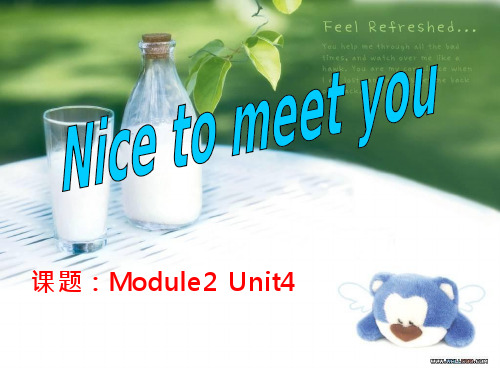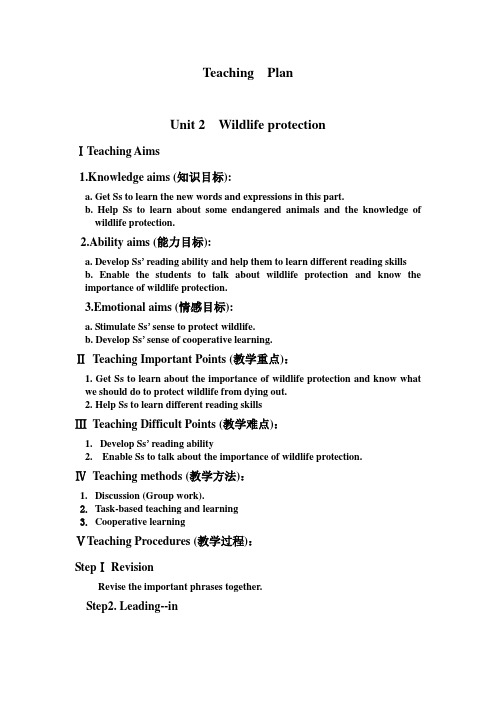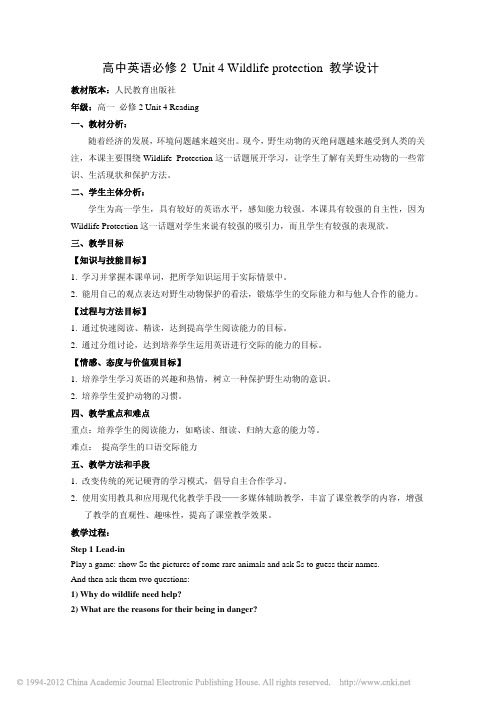高中英语《Wildlife-protection》优质课教案、教学设计
- 格式:docx
- 大小:772.54 KB
- 文档页数:11


英语学科教学设计(1)教学内容分析(2)课堂教学过程设计略读,找出文章主旨大意(5--10 min) (1)播放课文录音。
(2)教师让学生采用略读的技巧,快速找出文章的主旨大意,以填空题的形式呈现。
T:“Read the text quicklyand grasp the main idea of the text.”(1)合上课本,听课文录音;(2)学生快速的略读完全文,并集体完成空格的填写。
Textbook&PPT首先让学生听课文录音,帮助学生对要学习的内容有一个大致的了解,同时也锻炼了学生的听力水平。
在此基础上再训练学生的快速阅读技能。
教师通过让学生通读全文,弄清楚文章的主旨大意,有利于学生对本文有一个整体的把握同时,也训练了学生快速阅读的能力。
填空的形式更易于学生完成任务。
寻读,理清文章脉络和主要细节(10--14mi n) (1)教师让学生采用寻读的方式了解Daisy的三次行程和经历,并填写表格。
T:“Read the passage quickly and try tofill in the table below about Daisy’sjourney.”(2)判断文章重要信息点的正误True/False(1)学生在老师的要求下,对文章进行寻读,找出Daisy的三次行程并完成表格的填写。
男女分工,男生负责回答遇见的动物,女生负责回答到达的地点。
(2)学生单个回答。
读出句子并判断正误,对错误选项要加以改正。
Textbook&PPT该环节能帮助学生从宏观和微观两个层面来把握全文。
填表题有利于学生从宏观上把握文章的主要内容:主人公的三次主要经历,即遇见的动物和到达的地点。
男女分工,丰富了课堂活动形式;判断正误题有利于学生了解和把握文中的重要细节,培养他们寻找特定信息的能力。
个人活动与分工协作相互融合,提高了学生的阅读效率。
细读,处理每段细节(14--24mi n) .仔细阅读环节,教师设计了三个任务。

Unit 4 Wildlife ProtectionThe first periodWarming upKnowledge aims:a. help Ss to understand and master the words and expressions in warming up.b. Let the students know some basic information about the endangered animals and wildlife situation and protection.Ability aims:Encourage Ss to think and express their attitude towards the wildlife and the wildlife protection.Emotional aims:a. Help Ss understand the importance of the wildlife protection and make them be more active in the helping wildlife.b. Develop Ss’ sense of cooperative learning.Teaching Key Points:Enable the students to know some basic information about the endangered animals and wildlife protection.Encourage Ss to think and express their attitude towards the wildlife and the wildlife protection.Teaching Difficult Points:How to enable the students express themselves freely.Teaching Materials:Blackboard, multi-media, and other normal teaching tools.Teaching methods:Co-operative learningStudents-centered approach & Task-based teaching and learningTeaching Procedures:Step 1: Lead-inLead in by explaining the title and predicting what will be learned in this lesson. Step 2: ExplorationTask: let the students explore the following question:What is the problem of wild animals commonly facing?1. Show some pictures to the students. Students watch the pictures and say what the pictures tell us.References: food shortage, pollution, destruction of habitat, over-hunting.2. Show the students three more pictures and ask: what do people kill or hunt these animals for?From these pictures, students can conclude that people kill animals for food, for fur, for medicine and for works of art.3. Ask the students to give their answers to the question: What is the problem of wild animals commonly facing?Step 3: Discussion1. Let the students discuss the following question: why should we pay attention to wild animals and plants.Students discuss the question in groups and then give their opinions.2. After discussion, tell students what is wildlife protection about.Step 4: Group work1. Let the students read the report on some endangered wildlife in China at page 25, SB.2. Ask the students some questions about the report.3. Let the students describe the chart in small groups according to the sample.4. Discussion. More and more animals are killed by humans, as a student what should you do to protect the wild animals?Step 5: HomeworkWrite a composition according to the tips.假如你是一名记者,采访某动物园负责人有关国宝大熊猫的情况。

M2U4 Wildlife Protection 高三一轮复习课一、教学内容本节课是高三一轮复习课,通过人教版高中英语模块2 unit4 的复习,使学生掌握本单元的重点词汇,单词以及句型,并能将所学的词汇,举行等应用于写作,选词填空等练习,并且能意识到保护野生动物的重要性以及能提出相应的措施。
二、学习目标和任务掌握相关的词汇(知识技能)从政府、个人、媒体三方面为保护频临没绝认识保护动物的重的野生动物提出一些有效措施(核心任务)要性(情感态度价值观)语法项目:定语从句的应用以及现在进行时的被动语态的应用(知识)自主学习和合作学习(过程与方法)训练写作技能(技能)三、教学重点:1、掌握本单元的相关词汇,例如endangered,decrease, now for sure, be in common, with 复合结构等。
2、定语从句的应用以及现在进行时的被动语态的使用范畴和应用。
3、关于动物保护文章的写作训练。
四、教学难点:1、定语从句的应用2、课堂写作的训练五、先学任务1、完成教师自己编写的第四单元练习卷。
【设计意图】练习卷设计近年来高考试题,涉及到本单元的词汇、语法等项目,完成这项任务的目的就是要求学生对本单元的重点词汇、表达以及语法等有相应的自我复习和诊断,了解自己对本单元词汇以及语法项目的掌握情况并且做好记录,上课可以进行针对性的复习。
2、熟悉课文,准备句子翻译。
【设计意图】利用早自修的时间,让学生熟读课文,准备句子翻译。
根据学生水平,为了提高他们的学习积极性以及学习的成就感,有些难一点的句子教师事先给我范围。
六、教学片断1)、课堂导入、作业反馈和针对讲评Step1. Lead in and feedback from the homework1). Appreciate an MV of MJ’s “Earth Song”to arouse students’interest as well as introduce the topic.2). Give some feedback from the homework including the students who did a good job in the homework as wall as the students that made great progress recently.3). List the number of the students that made a mistake in each item and explain the ones they needed, such as Q5, which 25 students chose the wrong answer, as well as Q6,8,10. As the rest questions, leave them to the students themselves for discussion.【设计意图】通过MJ的试听输入,快速导入本单元的话题,激活学生么脑中有关野生动物保护的图示,点燃学生的复习热情,启动愉快的复习心情。

Teaching PlanUnit 2 Wildlife protectionⅠTeaching Aims1.Knowledge aims (知识目标):a. Get Ss to learn the new words and expressions in this part.b. Help Ss to learn about some endangered animals and the knowledge ofwildlife protection.2.Ability aims (能力目标):a. Develop Ss’ reading ability and help them to learn different reading skillsb. Enable the students to talk about wildlife protection and know the importance of wildlife protection.3.Emotional aims (情感目标):a. Stimulate Ss’ sense to protect wildlife.b. Develop Ss’ sense of cooperative learning.ⅡTeaching Important Points (教学重点):1. Get Ss to learn about the importance of wildlife protection and know what we should do to protect wildlife from dying out.2.Help Ss to learn different reading skillsⅢTeaching Difficult Points (教学难点):1.Develop Ss’ reading ability2. Enable Ss to talk about the importance of wildlife protection.ⅣTeaching methods (教学方法):1.Discussion (Group work).2.Task-based teaching and learning3.Cooperative learningⅤTeaching Procedures (教学过程):StepⅠ RevisionRevise the important phrases together.Step2. Leading--inUsing some pictures of endangered animals to lead in. Step3. Fast reading1. Read the story quickly and answer the questions◆◆◆Which places did she travel to?◆What animals did she visit?2. The main idea of the storyStep4. Careful reading1.Read quickly and finish the true or false questions2.Match the main idea of each part:Step5.Group work: DiscussionQ1. What relationship between people and wildlife should be ?Q2. what can we do to protect endangered animals?Step6. SummaryRetell the story: P Ex-bookStep7. Homework1.Review the passage on P26 and finish the exercises on P27.2.Review the new words and phrases of this unit.。

高中英语必修2 Unit 4 Wildlife protection 教学设计教材版本:人民教育出版社年级:高一必修2 Unit 4 Reading一、教材分析:随着经济的发展,环境问题越来越突出。
现今,野生动物的灭绝问题越来越受到人类的关注,本课主要围绕Wildlife Protection这一话题展开学习,让学生了解有关野生动物的一些常识、生活现状和保护方法。
二、学生主体分析:学生为高一学生,具有较好的英语水平,感知能力较强。
本课具有较强的自主性,因为Wildlife Protection这一话题对学生来说有较强的吸引力,而且学生有较强的表现欲。
三、教学目标【知识与技能目标】1. 学习并掌握本课单词,把所学知识运用于实际情景中。
2. 能用自己的观点表达对野生动物保护的看法,锻炼学生的交际能力和与他人合作的能力。
【过程与方法目标】1. 通过快速阅读、精读,达到提高学生阅读能力的目标。
2. 通过分组讨论,达到培养学生运用英语进行交际的能力的目标。
【情感、态度与价值观目标】1. 培养学生学习英语的兴趣和热情,树立一种保护野生动物的意识。
2. 培养学生爱护动物的习惯。
四、教学重点和难点重点:培养学生的阅读能力,如略读、细读、归纳大意的能力等。
难点:提高学生的口语交际能力五、教学方法和手段1. 改变传统的死记硬背的学习模式,倡导自主合作学习。
2. 使用实用教具和应用现代化教学手段——多媒体辅助教学,丰富了课堂教学的内容,增强了教学的直观性、趣味性,提高了课堂教学效果。
教学过程:Step 1 Lead-inPlay a game: show Ss the pictures of some rare animals and ask Ss to guess their names.And then ask them two questions:1) Why do wildlife need help?2) What are the reasons for their being in danger?Read the passage quickly and put these sentences in the right order. a. Daisy found her being watched by an elephant. b. Daisy woke up and found a flying carpet.c. As Daisy landed, things began to disappear, including the monkey.d. Daisy and her flying carpet were in a thick rainforest.e. Daisy looked at an antelope which was looking sad. Correct order: b-----e-----a------d------c设计意图:通过排序形式考查学生对文章整体的把握,了解文章的结构。
高中英语必修二U4 Wildlife protection教学设计1.整体设计思路、指导依据说明本节课体现的是《普通高中英语课程标准》规定的课程性质和理念:“使学生在义务教育阶段英语学习的基础上,进一步明确英语学习的目的,发展自主学习和合作学习的精神;在加强对学生综合语言运用能力培养的同时,注重学生用英语获取信息、处理信息、分析问题和解决问题的能力以及用英语进行思维和表达的能力。
”本节课以新课程标准的一些核心理念为依据,以任务型语言教学为主,通过实际生活中的真实语境,激发学生学习英语的兴趣,寓教于乐,倡导小组表演活动,小组讨论,鼓励学生全体参与课堂,在体验、实践、合作与交流的学习方式中,培养学生用英语表达的能力,理解保护野生动物的重要性,达到培养学生的社会责任感,提高思考和判断的能力,进而增进跨文化理解和跨文化交际意识。
本节课的设计重视课前的导入,重视课中学生的小组角色表演。
2. 教学背景分析教学内容分析:本节课必修二第四单元 Wildlife protection 的 Reading 部分。
本单元的话题“野生动物保护” 。
Reading 是整个单元的核心部分,是Warming up 的延续和升华。
此外,大部分的重要词汇和句型结构都在这个课时中呈现出来。
完成本节课的阅读,为本单元目标的完成作了很好的铺垫。
也是培养学生阅读能力的重要渠道,发展阅读技能和策略的必经之路。
文章介绍了一个叫Daisy 的小女孩在梦中经历的一次奇妙的飞毯飞行。
通过女孩和藏羚羊、非洲象、猴子的对话,学生进一步意识到野生动物的生存环境日益恶化以及保护野生动物的行动刻不容缓。
学生情况分析:教学对象为高一学生,所教班级的学生思维活跃,有强烈的求知欲望,认知能力比初中有了进一步的发展,到了高中逐渐形成用英语获取信息、处理信息、分析问题和解决问题的能力,具备一定的阅读理解能力,不再单纯地满足教科书上仅有的知识,有获取更多信息的欲望。
笔者注重提高学生用英语进行思维和表达的能力。
Wildlife ProtectionReading: How Daisy Learned to Help Wildlife一、课型分析:1.课型:阅读课2.教学内容及学生情况分析:1)教材分析本节课内容选自普通高中课程标准实验教科书人教版《英语》必修2,Unit4 Wildlife protection的阅读文章。
本单元的中心话题是野生动物保护,阅读课是这一单元教学的重要环节,通过warming-up, pre-reading, reading, comprehending 四个环节了解濒临灭绝的野生动物的生存现状,学会如何保护野生动物以及要从已经灭绝的动物中吸取哪些经验教训从而促进我们保护野生动物的意识。
整单元的听、说、读、写语言技能及语言知识学习,都围绕阅读主题Wildlife Protection展开,因此本节课在单元教学中占有重要地位。
2)学生分析1、授课对象为高一年级的学生, 学生英语基础相对薄弱。
2、三分之二多的学生熟悉tiger ,monkey, panda, elephant等常见的关于动物名称的单词。
3、学生预习了wildlife, protection 等本课新单词。
4、学生英语基础参差不齐。
大约三分之一的学生好奇心强,求知欲强,并善于接受新事物和新观念,表现热情高。
但大多数学生英语基础薄弱,掌握的词汇量不足,基本的英语听说能力尚有欠缺,阅读能力还有待加强和提高。
还有极个别学生只会读简单的单词。
5、学生有过小组合作经验,但不多。
二、教学目标知识与技能:1)掌握与野生动物保护有关的词汇和短语:wildlife, protection, endangered, decrease, importance, in danger (of),die out, protect …from, pay attention to , in peace, etc.2)能运用skimming 阅读技巧,找出文章主旨大意。
《Wildlife Protection 》教案设计(2011-04-22 23:17:47)转载▼标签:杂谈《Wildlife Protection》教学设计2008212716屈嘉琪外援英语系章节名称Unit 4 Wildlife Protection课时4所选教材新课标人教版英语必修2所属学科英语教学对象高一学生一、教学目标Teaching Aims知识与技能a. help students to understand and master the words and expressions帮助同学们理解并掌握一些单词和短语b. Let the students know some basic information about the endangered animals 让同学们了解一些关于濒临灭绝的动物基本信息过程与方法a. Encourage students to think and express their attitude towards the wildlife and the wildlife protection.鼓励同学们思考并表达他们关于野生动植物及其保护的态度b. Enhance students’ reading ability and develop students’ ability and skills of guessing words and reading comprehension.提高学生们的阅读理解能力,并发展其猜词的能力和技巧情感态度价值观a. Help students understand the importance of the wildlife protection and make them be more active in the helping wildlife.帮助学生理解保护野生动植物的重要性,并让他们更积极参与帮助野生动植物的活动b. Develop students’ sense of cooperative learning.培养学生们合作学习的意识二、教学重难点Teaching Key and Difficult Points:项目内容解决措施教学重点a. To train the readingcomprehension to the wholepassage培养对整个课文的阅读理解能力b. To improve students’通过查阅资料、浏览图片、课文阅读,了解野生动植物及其保护的含义和方法,并能够自由的运用做学知识进行说话及写作ability of listening, speaking, reading and writing.提高学生的听说读写能力教学难点Enhance the studentsreading skills in the passage.提高学生们的课文阅读技巧通过让学生回答问题,填空,判断正误等反复练习逐渐提高其能力三、教学媒体资源的选择资源点编号学习目标媒体类型媒体内容教学作用使用方式所得结论占用时间媒体来源4-1知识与技能资源库1(图片、文字)野生动植物的照片A、C、KF、G、H1对野生动植物形成初步感受20分钟网上下载4-2过程与方法资源库2(图片、声音、文字)课文内容和野生动植物图片A、B、C、GB、D、H1深入了解野生动植物45分钟自制和网上下载4-3资源库3(图片、文字)语法讲解E、F、G、JE、F、H1、H2了解现在进行时的被动语态45分钟网上下载4-4情感态度价值观资源库4(图片、文字)口语和实践B、G、J、K2B、F、H2锻炼学生口语和思辨能力,拓展学生课外知识25分钟网上下载1) 媒体在教学中的作用分为:A提供事实,建立经验;B.创设情境,引发动机;C.举例验证,建立概念;D提供范例,正确操作;E.呈现过程,形成表兄;F.演绎原来,启发思维;G.设难置疑,引发思维;H.展示事例,开拓视野;I.欣赏审美,陶冶情操;J.归纳总结,复习巩固;K1. 网络浏览,丰富语言;K2. 网络交流,评价反馈。
高中英语
《Wildlife-
protection》优质课
教案、教学设计
-CAL-FENGHAI-(2020YEAR-YICAI)_JINGBIAN
Book 2 Unit 4 Wildlife Protection
Reading:How Daisy Learned To Help Wildlife
教 学 设 计
Teaching aims:
1. Knowledge aims: Make the students master some useful
words and expressions and learn something about wildlife
protection.
2. Ability aims: Improve the students’ reading ability by
using different reading skills.
3. Emotional aims: Stimulate the students’ sense to
protect wildlife and develop the students’ sense of
cooperative learning.
Teaching key point:
Improve the students’ reading ability.
Teaching difficult point:
Enable the students to learn something about wildlife protection.
Teaching methods:
1. The Multi-media Assistant Teaching Approach
2. The Task-based Teaching and Learning Approach
3. The Whole Language Teaching and Learning Approach
Teaching aids:
A projector, a multi-media computer system and the blackboard.
Teaching procedures:
Step1. Revision : Have a dictation to some key phrases.
1.
灭亡
2.
和平地
3.
在危险中
4.
如释重负
5.
突然笑起来
6.
保护……不受……
7.
注意
8.
形成,产生
9.
按照;根据
Step2. Free talk and summary: What makes the world around
us so wonderful?
Step3. Lead-in:
1. Enjoy more pictures about animals together. Watch and
give us their names. (Pictures)
2. Watch and think: What’s the problem of these animals
commonly facing?
3.
4
Why?
4. Brainstorming: Why are these animals dying out?
5. Summary: Reasons for their dying out
6
Reasons
Step 4. Warming up:
1. Look at a report on some endangered wildlife in China.
2. Think it over: What do you think we can do to protect wild
animals?
Step 5. Reading
1. Fast reading for general ideas.
Who is the character of the story?
How did she travel?
Which places did she travel to?
What animals did she visit?
2. Careful reading for detailed information.
(1) What happened to the elephants in Zimbabwe?
(2)
(3) Try to understand: What does the sentence “No rain forest,
no animals and no drugs” mean?
(4)
Step 6. Read the passage and retell the story.
One day, Daisy d a strange dream. She flew in a
wonderful c to t with an a in Tibet. The
antelope told her they were hunted because of their f which
can be used to make s like hers. In 3 years they may
all be gone. Later, she f to Z where she talked
with an e and got to know the farmer there no longer
h them. That’s because the g decided to
help and the farmers finally made a lot of m . At last she
a at the thick rain f where a monkey told her “ No
rain forest, no a and no d .” Although finally
everything was g , she had l so much.
Step 7. Homework
1. Read and recite the retelling passage.
2. Surf the Internet to find more information about the wildlife
protection and design a poster of wildlife protection
板书设计
Unit 4 Wildlife protection
Reading: How Daisy Learned to Help Wildlife
10
Reasons